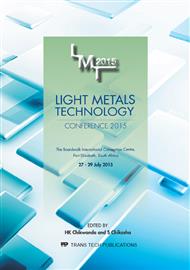[1]
J. -P. Kruth, J. Deckers, E. Yasa, E. and R. Wauthle, Assessing and comparing influencing factors of residual stresses in selective laser melting using a novel analysis method, in: Proc. IMechE Part B: J Engineering Manufacture, 1–12, Catholic University of Leuven 2012, doi: 10. 1177/0954405412437085.
DOI: 10.1177/0954405412437085
Google Scholar
[2]
B. Vrancken, B., R. Wauthle, J. P. Kruth, and J. Van Humbeeck, Study of the influence of material properties on residual stress in selective laser melting. In: D. Bourell et al., eds. Proceedings of the 2013 Solid Freeform Fabrication Symposium. Austin, TX: University of Texas at Austin, 393–407.
Google Scholar
[3]
C.R. Knowles, T.H. Becker and R.B. Tait, Residual stress measurements and structural integrity implications for selective laser melted TI-6Al-4V. S. A. J. Ind. Eng. 23/3 (2012) 119-129.
DOI: 10.7166/23-3-515
Google Scholar
[4]
B. Vrancken, V. Cain, R. Knutsen and J. Van Humbeeck, Residual stress via the contour method in compact tension specimens produced via selective laser melting. Scripta Materialia, 87/15 (2014) 29–32.
DOI: 10.1016/j.scriptamat.2014.05.016
Google Scholar
[5]
D. Buchbinder, W. Meiners, N. Pirch, K. Wissenbach, and J. Schrage, Investigation on reducing distortion by preheating during manufacture of aluminum components using selective laser melting, J. Laser Appl. 26 (2014) 012004.
DOI: 10.2351/1.4828755
Google Scholar
[6]
N. Passas, C. Butenuth and M. H. de Freitas, A non-volumetric method of measuring the ratio of solid and voids in porous material with a computer aided system. Bulletin of the International Association of Engineering Geology, 53/1 (1996) 83-95.
DOI: 10.1007/bf02594944
Google Scholar
[7]
P. Rangaswamy, H. Choo, M. B. Prime, M.A.M. Bourke and J.M. Larsen, High temperature stress assessment in SCS-6/Ti-6Al-4V composite using neutron diffraction and Finite Element Modeling, in: Proc. THERMEC 2000, Int. Conf. on Processing & Manufacturing of Advanced Materials, December 4-8, 2000, Las Vegas, USA.
Google Scholar
[8]
Information on www. matweb. com.
Google Scholar
[9]
C. Veiga, J.P. Davim and A.J.R. Loureiro, Properties and applications of titanium alloys: a brief review. Rev. Adv. Mater. Sci. 32 (2012) 133-148.
Google Scholar
[10]
N. Passas, C. Butenuth, M. H. de Freitas. A non-volumetric method of measuring the ratio of solid and voids in porous material with a computer aided system. Bulletin of the International Association of Engineering Geology - Bulletin de l'Association Internationale de Géologie de l'Ingénieur. 53(1) (1996).
DOI: 10.1007/bf02594944
Google Scholar
[11]
H. Rafi, N. Karthik, H. Gong, T. Starr and B. Stucker, Microstructures and mechanical properties of Ti6Al4V parts fabricated by Selective Laser Melting and Electron Beam Melting, JMEP 22/12 (2013) 3873-3883.
DOI: 10.1007/s11665-013-0658-0
Google Scholar
[12]
I. Yadroitsava and I. Yadroitsev, Evaluation of Residual Stress in Selective Laser Melting of 316L Steel, in: Proc. 1st Int. Conference on Progress in Additive Manufacturing. Eds: Chua Ch. K., Yeong W. Y., Tan M. J. and Liu E., 26 – 28 May 2014, Singapore.
DOI: 10.3850/978-981-09-0446-3_038
Google Scholar
[13]
U. De Oliveira, V. Ocelík, and J.T. De Hosson, Residual stress analysis in Co-based laser clad layers by laboratory X-rays and synchrotron diffraction techniques. Surf. Coat. Tech. 201 (2006) 533–542.
DOI: 10.1016/j.surfcoat.2005.12.011
Google Scholar


